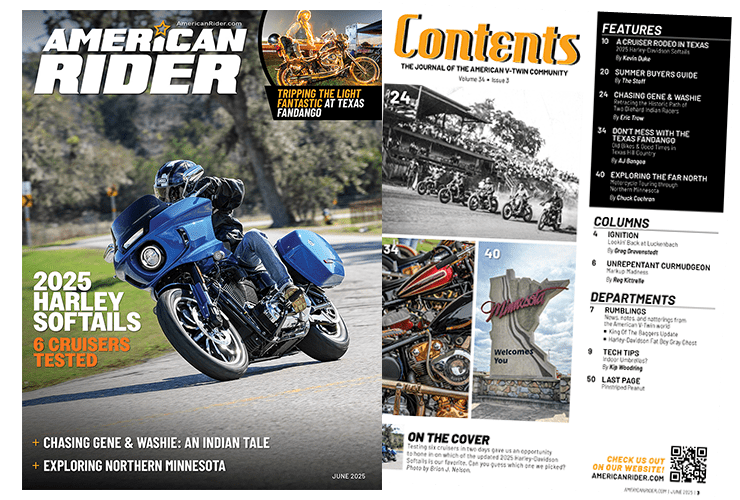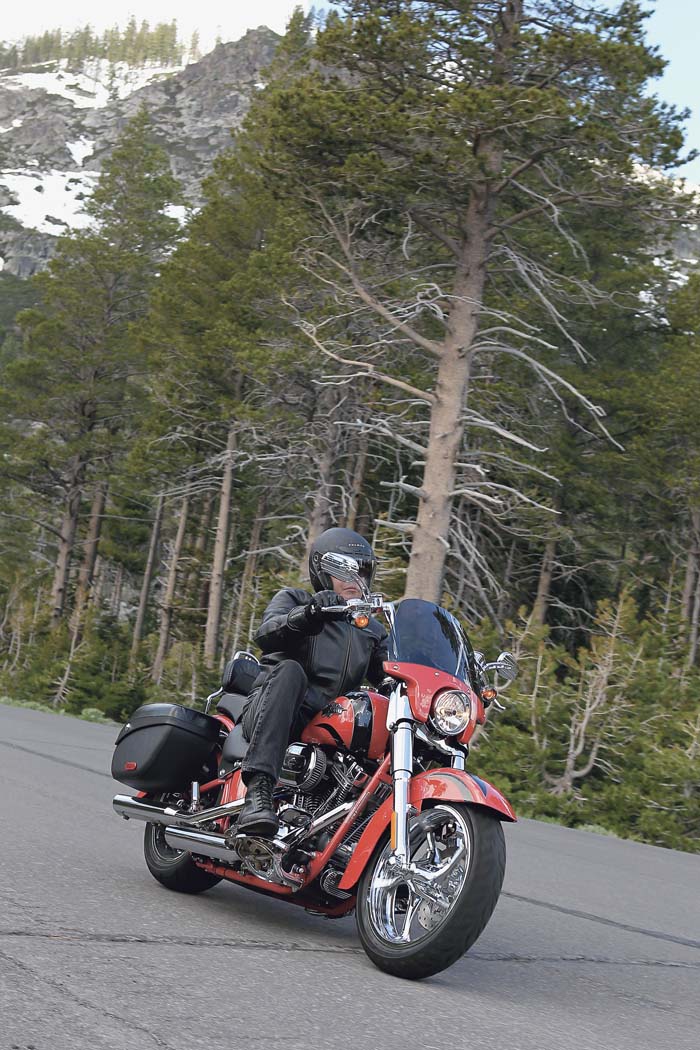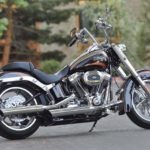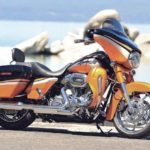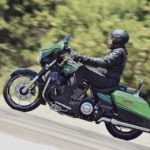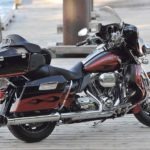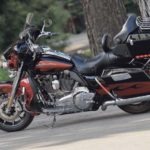Glad rags and saddlebags
And that highway song in four-part harmony
Incline Village, Nev., June 16—Dawn breaks cold over Lake Tahoe after a night in the 30s and the heavy snows of the winter just past remain in abundant evidence on the peaks surrounding the basin. The sky’s an auspicious blue and the whole tableau is as breathtaking as it is brisk. It’s shaping up to be a brilliant day for a long ride in the high country, provided you’re properly geared up for the frigid conditions—meaning, in short, that this is full-dresser weather for both man and bike alike.
In that regard it’s the ideal setting for Harley-Davidson’s Custom Vehicle Operations crew, better known as CVO, to roll out their 2011 collection and demonstrate, in effect, that after 13 years of wild-eyed dabbling in street rod styling flourishes and exotic cosmetic techniques on a wide assortment of specimens from across the whole Big Twin and VRSC gamut of Milwaukee platforms, they’ve sobered up, changed their tune, shredded their playbook, defied their own traditions, and reinvented themselves as the CBO—Custom Bagger Operations.
Serious high-style touring is what the entire 2011 line-up is all about, from the Cunard-quality luxo-tourers represented by the CVO Ultra Classic Electra Glide and Road Glide Ultra, to the haute-custom bagger elan of the Street Glide to the bad-ass high-tech minimalism of the Softail Convertible. Every one of the four models has a fairing, saddlebags, sound system andfootboards, and that refocusing of the CVO gaze could hardly have come at a more opportune time. That’s because it’s become glaringly apparent that the rapid rise of the bagger genre to unquestioned market preeminence in recent years is more than a passing fad. Like it or not (I really like it), baggers are the face of the future, and Harley-Davidson has long been the 800-pound gorilla (literally) in that genre. But there’s another reason why the touring focus of the new CVO stable could not have come at a more opportune time and that’s because, as I may have mentioned, it’s freaking cold up here.
And what’s more, the day’s ride route would lead uphill and flirt with 8,000-foot elevations where the snow lingers stubbornly in the roadside shadows. It all promised some numbing exposure in the saddle unless, that is, your exposure was limited and the saddle heated. And maybe the handgrips too. At least that’s the thought that crossed the minds of many members of the moto-press assembled at the lakeside lodge for the breakfast tech briefing and model unveiling. How else to explain their none-too-subtle stampede out to the test bikes to lay claim to an Ultra at the conclusion of the meeting, napkins still dangling from their collars and muffin crumbs still flecking their countenances?
I, of course, was not among their number, figuring that preserving my dignity was more important than conserving my body heat, and besides, my sights were happily set on the Softail Convertible. In many fundamental ways it’s the breakout model of the year, and cozy enough in the cold to boot, if you’re no sissy, so that’s where we’ll start our rundown of the 2011 CVO offerings.
Shapely shapeshifter
The CVO Softail Convertible debuted last year as a completely unique model, one with no precursor and no counterpart in the Harley-Davidson core line-up. It brought with it a revival of the long-abandoned and oft-lamented “convertible” concept of buy-one-get-two that, in the case of the CVO model, offered the buyer both a legitimate middle-distance tourer with a quick-detach complement of fairing, saddlebags, pillion and backrest, as well as a lavishly tricked-out boulevardier once those amenities were removed. A real attractive package, it was, and one that we tested extensively and praised just as much.
But the bike was just a warm-up act for what it’s become for 2011.
The list of dramatic upgrades to the bike’s touring persona is long and starts with the conversion to an electronic throttle system. Also known as “fly-by-wire,” this technology came to Harley’s Tourer models in 2008. Aside from the adjustment and maintenance advantage it holds over conventional cable setups, it enables the fitment of an electronic cruise control as well as an antilock braking system (ABS). Both of these features arewelcome additions for serious road work. Unlike the cruise control setups on the Tourers, which entail both an on/off switch on the dash and a resume/set button on the handgrip control module, the Convertible makes do with just the latter. Push the button to turn it on or off, and use the resume/ set to increase or diminish the cruising speed.
The Convertible is also given a new set of saddlebags that offer both superior capacity and operation. They’re now large enough to hold a half-shell helmet, and they have a flip-lid design similar to the hard bags on the Tourer models, and even easier to manipulate. They eliminate the awkwardness of fiddling with the four strap latches of last year’s model, and they incorporate a pair of locks as well.
In keeping with the CVO’s stated “Big Audio” theme for all of the 2011 models, the Convertible now sports a sound system—the first Softail model so equipped. That system consists of a pair of 3.5″ two-way speakers housed in the quick-detach fairing along with a 20 watt/channel amplifier and a dock for an MP3 or iPod. It’s a rudimentary system with limited functionality on-the-fly and a level of fidelity best appreciated at slow speeds or parked at your destination, but hey, you got your tunes. And an 8-gigabyte iPod Nano with AM/FM and a case comes with the bike.
All of those upgrades enhance the Convertible’s touring credentials, but its stripped-down street-custom identity did not go ignored in the process, and the model now boasts Milwaukee’s first-ever foray into welded handlebars. These apish 1.25″ creations bring the fashionably retro “Z-bar” look to the bike while still running all wiring internally in signature CVO fashion, a trick that involves elbow conduits being installed within before the welding is done.
From there the new Convertible’s revisions go from the functional and fashionable to the bizarre and downright inexplicable, as in: This bike has no ignition switch. It’s vanished. In its place is simply the key fob in your pocket that uses the familiar Smart Security proximity-sensingtechnology to inform the ignition that you’re thereand it’s OK to fire up. So the drill goes like this: climb aboard with your key fob on you, flip on the run switch (a.k.a. the kill switch), and thumb the starter button. To shut down, you turn off the run switch and leave it in the off position while parked. The procedure takes some adapting to, as you might suspect, and you still need to use a key to lock the forks and saddlebags, so I’m not sure what’s really been achieved with this wizardry besides flaunting some wizardry. Good conversation piece, though.
The CVO Softail Convertible is offered in three mouth-watering color combinations, Scarlet Red Pearl and Dark Slate Pearl with Metal Grind graphics; Midnight Sky and Candy Cobalt with Ice Blue graphics; and Maple Metallic and Roman Gold with Burnished Copper graphics. The list price is $29,599, and 2,400 units will be produced.
Milwaukee sound machine
Also returning for a second appearance is the CVO Street Glide, and it likewise receives a heady dose of new features, both functional and cosmetic. By far the biggest modification to the machine, though, is a conceptual one, and it’s the repurposing of the model from a dressed-down custom bagger to a dressed-up custom boom box. This bike was essentially configured around sound—specifically the potent new 100-watts/channel audio system with its three-way, six-speaker array. The fairing still houses the pair of 5.25″ two-way speakers it had last year, but now adds a pair of tweeters in the slots previously occupied by the fuel gauge and voltmeter. More momentously, a pair of fairing lowers has been affixed this year and stuffed with an imposing pair of 6.5″ speakers. The lowers also serve to improve wind protection as well as to seal in the sounds blasting from the mighty stereo. The same can be said to some extent for the 7″ windscreen added this year in place of the low-profile 4″ job.
The right saddlebag gets in on the sound machine act as well. Just beneath the lid inside you’ll discover an interface dock for an MP3 or iPod, and like the Convertible, the Street Glide comes with your very own CVO-engraved iPod Nano.
Within the revamped fairing the displaced voltmeter has moved to the former slot of the air temperature gauge, which has been jettisoned entirely and won’t be missed. The fuel gauge also leaves the dash entirely and moves to the Street Glide’s new fuel tank.
And what a tank it is. A flush-mount fill cap on the right side replaces the conventional center-fill fixture found on all other Tourer models, and a dummy left-side cap displays fuel level in LED gradations. Between the two is a sleek and handsome two-tone console. On the tank sides are a pair of new “liquid metal” escutcheons where before there were only decals.
Cosmetically, the Street Glide benefits from a 19-inch front Agitator wheel (that takes the Tourer platform to new heights in that department), a smooth alligator-trimmed saddle, and fluted chrome billet end caps on the mufflers. And that’s just the beginning, since the specific package of cosmetic treatments to the wheels, motor, console and end caps depends to an unprecedented degree on which of the four color schemes offered this year you choose.
The most radical package of all is the Kryptonite and Black Diamond model and not just because it flies in the face of the old “green Harleys spell doom” superstition. This option brings with it a gloss-black finish on the TC110 motor instead of the standard granite hue of all other 2011 CVOs. It sets that off with Chrome Contrast Agitator wheels that have black highlights, and with black/chrome exhaust tips. Combine all that with the splashy new graphic scheme of the 2011 Street Glides, and you’ve got a truly flamboyant stunner of a scoot.
The other colors available on the Street Glide are Autumn Haze and Antique Gunstock, Black Diamond and Inferno Orange, and Black Diamond with Crimson Tag graphics. Take your pick for $32,499. There will be 3,400 units assembled—by far the most of any 2011 CVO model.
New bruiser on the block
The high point of this year’s CVO model launch had to be the unveiling of the CVO Road Glide Ultra, in large measure because we just didn’t see it coming. When the long-running tour-dedicated FLTR failed to appear in last year’s OE stable, replaced, it seemed, by the decidedly more street-oriented Road Glide Custom, there was a collective moan among RG fanciers who feared the worst—that their stalwart favorite had run its course. We know now from our Motor Company sources that no such fate was ever intended and that, in fact, the Road Glide Ultra on which the new CVO model is based was actually slated for a 2010 debut, but for whatever reason, wasn’t quite ready to emerge.
We also know now that it was worth the wait. It’s an entirely new creation that owes more conceptually to the Tour Glide Ultra Classic of the ’90s than to any predecessor in its Road Glide lineage. And the CVO Road Glide Ultra owes a good deal to the CVO Ultra Classic Electra Glide, too, being the immediate beneficiary of much of that venerable model’s ongoing development. It receives, for example, the Deluxe Tour-Pak with its plush environs and LED brake/tail light array. It gets LED lighting inside the saddlebags and trunk as well as the carry-out liners for each. It shares the dual-control heated seat with its super-comfy “hammock-style” operator perch, and the passenger backrest with its nifty lumbar support apparatus that allows positioning of the support bar in or out with a knob on the armrest. And new for both models this year is a passenger seat with built-in suspension consisting of a pair of rails running lengthwise and acting as leaf springs for the tush.
The two models are both fitted for 2011 with a state-of-the-art Garmin Road Tech zumo 660 GPS that interfaces with the audio system to deliver verbal directions through the system, and override the music when necessary. On the Road Glide theGPS screen mounts on the handlebar, while the Electra Glide has it mounted on the fairing liner above the dash. An upgraded remote locking system that now secures the ignition in addition to the Tour-Pak saddlebags and ignition with the push of a button on the key fob is yet another commonality, as are the handsome new chrome billet exhaust end caps.
That’s a great head start for the Road Glide Ultra in CVO land, but only a start as the model comes loaded with a number of its own unique features. The audio system is a Harmon Kardon 40-watts/channel unit with an amplifier equalized specifically for the frame-mount fairing, and it plays through a set of four BOOM! High Performance Bagger speakers. The system also has XM satellite radio and a saddlebag-housed MP3/iPod dock and iPod Nano like the Street Glide.
More noteworthy, however, is what they’ve done in the name of improving wind properties within the cockpit, which have long been a complaint of taller riders, and which any number of aftermarket products have been offered to address. Here Harley has tackled the matter with a newly configured windscreen that’s been rounded and angled up to reduce the buffeting about the helmet that’s the source of the complaints. They’ve also added wind deflectors on top of the fairing lowers to close off the gap between them and the forward-positioned fairing. It’s hard to say exactly how much each of these modifications contributes to the net effect inside the bubble, but that net effect is significant. Some buffeting remains at speed, and the batwing fairing is still superior in that arena, but the improvement over previous Road Glides is indisputable—and much appreciated.
Choose from Rio Red and Black Ember, Charcoal Slate and Black Twilight or—our favorite and cover model—Frosted Ivory and Vintage Gold. The CVO Road Glide Ultra costs $35,999 and production is limited to 3,000 units.
Not fade away
The seemingly perpetual CVO Ultra Classic Electra Glide makes 2011 its sixth consecutive year in the CVO line-up, and it appears in its seventh iteration when you count the mid-2010 FLHTCUSE5-BLK rendition. All those years of progressive upgrades and compounding touring amenities produced annually the most opulently outfitted long-distance rig available—the undisputed King of the Highway. That’s a crown it may well have to share with the new CVO Road Glide Ultra in 2011 as the two models share all of the many features referenced earlier.
The Ultra Classic has also long held the title as the biggest selling CVO model, but that will most certainly change this year, and not because it’s necessarily lost popularity, but because there just won’t be many of them available. Production of the model is set at a relatively scant 1,500 units—less than half the output we’ve come to expect. Also being downsized is the variety of color schemes offered on the model for 2011. There will be just one, Black Ember and Rio Red with Flame Graphics. What that portends for the Ultra Classic’s CVO future is anyone’s guess at this point, but if it is indeed in eclipse it’s tantalizing to speculate what manner of luxo-tourer will next emerge from the fevered imaginations of the CVO (our money’s on a Tri Glide—at long odds). In any event, at a list price of $36,499 the Ultra Classic Electra Glide still retains its status as the most expensive CVO model.

